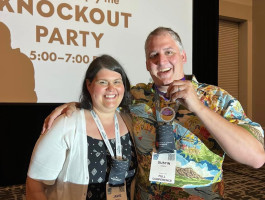Brew Log History
Target 68°F
Ambient: {{ stats.ambient | number:0 }} °F
OG: {{ stats.ogGravity | number:3 }}
Attenuation: {{ stats.attenuation | number:2 }}%
Calories: {{ stats.calories | number:1 }} / 12oz
Carbs: {{ stats.carbs | number:1 }} g / 12oz
Readings: {{ readingsCount | number }}
{{ formatHeaderDate(dates.navStart) | date:'mediumDate' }} to {{ formatHeaderDate(dates.navEnd) | date:'mediumDate' }}
Last Updated: {{ stats.lastupdated.ago }} from {{ stats.lastupdated.source }}
Fermentables
|
Amount
|
Fermentable
|
Cost
|
PPG
|
°L |
Bill %
|
|
45 lb |
Apple45 lb Apple |
|
5.6 |
0 |
100% |
|
45 lbs / $ 0.00
|
Other Ingredients
|
Amount
|
Name
|
Cost
|
Type
|
Use
|
Time
|
|
5 g |
Fermaid O
|
|
Other |
Primary |
0 min. |
|
6 each |
Campden Tablet
|
|
Other |
Primary |
0 min. |
|
6.50 g |
go ferm
|
|
Water Agt |
Primary |
0 min. |
|
2.50 tsp |
dry pectic enzyme
|
|
Water Agt |
Primary |
0 min. |
Priming
|
Method: co2
Amount: 14.89 psi
Temp: 45 °F
CO2 Level: 2.5 Volumes |
Target Water Profile
Balanced Profile
| Ca+2 |
Mg+2 |
Na+ |
Cl- |
SO4-2 |
HCO3- |
|
0 |
0 |
0 |
0 |
0 |
0 |
Notes
Pressed enough apples for 10 gallons of cider. Apples came from my dad's summer culinary tree and summer crab apple tree. I tried to mix apples evenly before pressing.
- add crushed campden tablets 24 hours prior to yeast pitch.
- add pectic enzyme when adding campden tablets
- Rehydrate yeast with about 1/4 cup of water that has been boiled with go form. Use an ice bath to cool the solution down before adding yeast. Let yeast rehydrate for thirty mins before pitching into cider.
- After fermentation has started, add hydrated fermaid o with about 1/8 to 1/4 cup cooled water (with chlorine removed).
Oxygenated cider with pure O2 for 1min 10 sec.
Yeast:
Red Star Premier Blanc in 5 gal - 1.048 OG
Mangrove Jack M02 in 5 gal - 1.05 OG
Apples gathered on 8/25/2018
Cider pressed on 8/26/2018
Packaging - Kegging ONLY
NOTE: These steps must be followed in order. If metabisulfite is added after sorbate then chemical reactions can occur that will give the cider a 'geranium' off flavor.
- add 1/4 tsp potassium metabisulfite to 5 gal of cider to inhibit yeast and bacterial growth.
- Wait at least 12 hours.
- add 2-1/2 tsp potassium sorbate to 5 gal of cider to halt fermentation.
- Wait at least 24 hours. 48 hours is ideal.
- Transfer cider to a keg.
- Purge oxygen from headspace.
- Remove a sample of cider and add apple juice concentrate until you're happy with the flavor.
- Take a gravity reading of the cider sample, then dose the main batch until the gravity readings match. Err on the side of too little.
- carbonate to desired levels
Very good read on backsweetening -
http://beersmith.com/blog/2017/03/07/how-to-backsweeten-beer-cider-and-mead/
8/23/2019 tasting notes:
I tasted and back-sweetened the ciders today. The preference of my wife and I was the champagne yeast batch. The champagne yeast batch had a dry champagne quality that we both enjoyed; it was smoother too. The mangrove jack batch was nice an clean, with a slight bitterness on the backend. Both finished at 0.994. I tend to like my cider on the dryer side, but not bone dry. I back-sweetened the mangrove jack cider to 1.002 and the champagne yeast cider to .999 with frozen apple juice concentrate from the grocery store. I decided to backsweeten the mangrove jack batch a little more to help balance out the bitterness; it seemed to do the trick. No additional tannins or acidity were required. The crab apples did a great job of adding the acidity the cider needed.
The mangrove jack cider was slightly more bitter than the champagne batch, this is probably due to the ratio of crab apples to culinary apples. The champagne batch was obviously darker than the mangrove jack. This could be due to oxidation or the ratio of apples. The cider carboy was less full, while the mangrove jack carboy was filled to the brim, so oxidation could certainly be a factor. However, campden tablets are supposed to help with oxidation, both batches certainly had a decent amount of campden tablets added to halt the yeast. I'm used to oxidation flavors in beer, I don't get those stale flavors from the champagne batch. The fact that my wife and I prefer the champagne batch would indicate that it's probably not oxidized. Time will tell, I'll update this if it starts to exibit oxidation flavors.

Last Updated and Sharing

- Public: Yup, Shared
- Last Updated: 2022-12-29 22:22 UTC
For quick copying and pasting to a text based forum or email.
Click the Download as HTML file button below.
Recipe costs can be adjusted by changing the batch size. They won't be saved but will give you an idea of costs if your final yield was different.
|
Cost $ |
Cost % |
| Fermentables |
$ |
|
Steeping Grains
(Extract Only) |
$ |
|
| Hops |
$ |
|
| Yeast |
$ |
|
| Other |
$ |
|
| Cost Per Barrel |
$ 0.00 |
|
| Cost Per Pint |
$ 0.00 |
|
| Total Cost |
$ 0.00 |
|
Discussion about this recipe:

